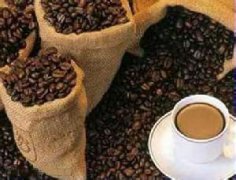The main components of coffee
Caffeine: Caffeine is the most widely known of all coffee ingredients. It belongs to a kind of plant xanthine (animal muscle component). Its nature is the same as theobromine contained in cocoa and theophylline contained in green tea. After baking, the percentage of reduction is extremely small. Caffeine has a very wide range of effects, which will affect various parts of the human brain, heart, blood vessels, gastrointestinal tract, muscles and kidneys. Appropriate amount of caffeine will stimulate the cerebral cortex, promote sensory judgment, memory and emotional activities, and make cardiac muscle function more active. Blood vessels will expand and blood circulation will be enhanced. And improve metabolic function, caffeine can also reduce muscle fatigue, promote digestive juice secretion. In addition to this, because it also promotes kidney function to help the body expel excess sodium ions (chemical components that hinder water molecule metabolism), caffeine will not accumulate in the body like other narcotic and excitatory substances (narcotic drugs, paint solvents, stimulants, etc.) in about two hours, but excessive intake will lead to caffeine poisoning. There is a particularly strong bitter taste, coffee flavor in the largest special roasting-bitter taste, is caused by caffeine.

Tannin acid: After extraction, tannin acid will become pale yellow powder, which is easy to blend into water. After boiling, it will decompose and produce pyrochloric acid, which will make coffee taste worse. If brewed well and put on for several hours, coffee color will become thicker than just brewed, and it will not taste enough, so there will be a saying that "brewed well, it is best to drink it as soon as possible."
Fat: Coffee contains fat, which plays an extremely important role in flavor. Analysis shows that coffee contains fat divided into many kinds, and the most important of them are acidic fat and volatile fat. Acidic fat refers to fat containing acid. Its strength will vary according to different types of coffee. Volatile fat is the main source of coffee aroma. Once the fat contained in roasted coffee beans comes into contact with air, chemical changes will occur, and the taste and aroma will deteriorate.
Protein: Coffee's main source of calories, the proportion is not high. Coffee powder protein in brewing coffee, most will not dissolve out, so intake is limited.
Sugar: Coffee beans contain about 8% sugar, most of which will be converted into caramel after roasting, making coffee brown and sweet with tannins.
Fiber: The fiber of raw beans will be carbonized after roasting. This caramelization of carbon and sugar combines with each other to form the color of coffee, but the fiber that turns into powder will bring a considerable degree of influence on coffee flavor. Therefore, we do not encourage the purchase of powdered coffee beans, because it is less able to taste the flavor of coffee.
Minerals: lime, iron, sulfur, sodium carbonate, phosphorus, chlorine, silicon, etc., due to the proportion of very little impact on the flavor of coffee is not large, combined to bring only a little astringency.
Aroma: Aroma is the life of coffee quality, but also the best performance of coffee production process and roasting technology, the climate of the production place, elevation, variety, refining treatment, harvest, storage, whether the roasting technology of the consumer country is appropriate, etc., are the conditions that control the aroma of coffee beans. The aroma of coffee was proved to be composed of hundreds of volatile components such as acids, alcohols, aldehydes, ketones, esters, sulfur compounds, phenols and nitrogen compounds. Roughly speaking, fat, protein, and sugar are important sources of aroma, while lipid components will blend with the bitterness and sourness of coffee to form a smooth taste. Therefore, the disappearance of aroma means that the quality is poor, and the relationship between aroma and quality is extremely close.
Important Notice :
前街咖啡 FrontStreet Coffee has moved to new addredd:
FrontStreet Coffee Address: 315,Donghua East Road,GuangZhou
Tel:020 38364473
- Prev

Cappuccino can be drunk dry or wet.
Cappuccino (Cappuccino)-at the beginning of the 20th century, the Italian Agatha invented the steam pressure coffee machine, but also developed the cappuccino coffee.
- Next

Notes and tricks for tasting coffee
In people's impression, coffee seems to be tied to milk and sugar.
Related
- Beginners will see the "Coffee pull flower" guide!
- What is the difference between ice blog purified milk and ordinary milk coffee?
- Why is the Philippines the largest producer of crops in Liberia?
- For coffee extraction, should the fine powder be retained?
- How does extracted espresso fill pressed powder? How much strength does it take to press the powder?
- How to make jasmine cold extract coffee? Is the jasmine + latte good?
- Will this little toy really make the coffee taste better? How does Lily Drip affect coffee extraction?
- Will the action of slapping the filter cup also affect coffee extraction?
- What's the difference between powder-to-water ratio and powder-to-liquid ratio?
- What is the Ethiopian local species? What does it have to do with Heirloom native species?

